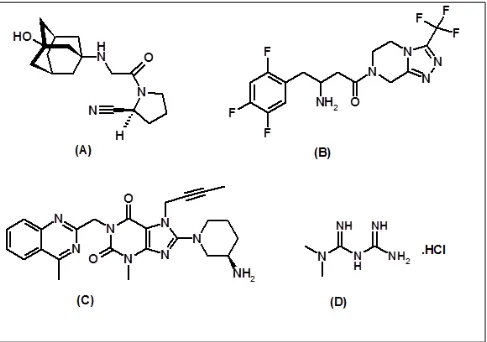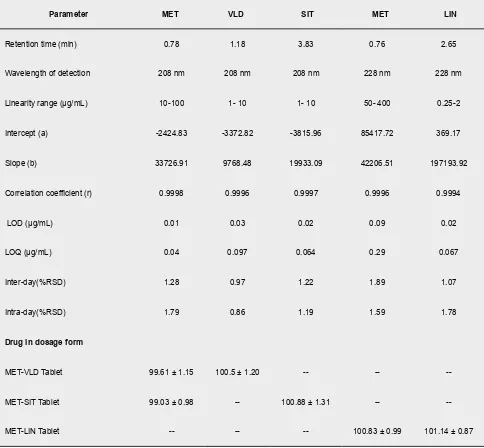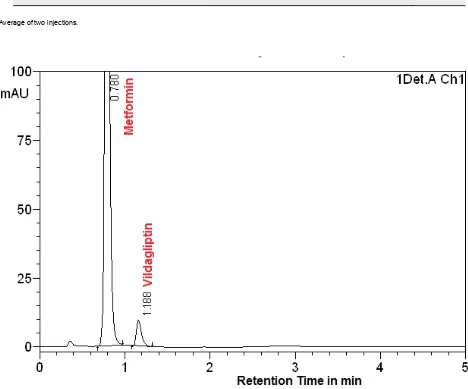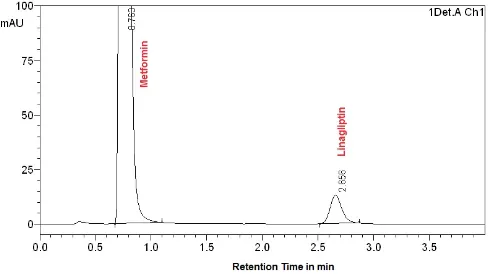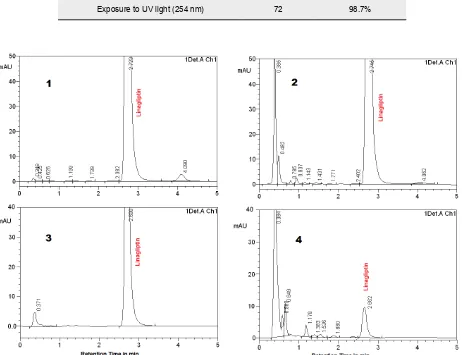www.ijper.org
Simultaneous Determination of Metformin and Three
Gliptins in Pharmaceutical Formulations Using RP
HPLC: Application to Stability Studies on Linagliptin
Tablet Formulation
Mahesh Attimarad*, Sree Harsha Nagaraja, Bandar E Aldhubaib, Anroop Nair and Venugopala K N College of Clinical Pharmacy, King Faisal University, Al Ahsa, Saudi Arabia
ABSTRACT
Objective: A simple, rapid and validated liquid chromatographic method has been developed for the simultaneous determination of three novel Gliptins namely Vildagliptin (VLD), Sitagliptin (SIT) and Linagliptin (LIN) in their binary mixture with Metformin (MET). Methodology: The separation was performed on fast monolithic column using isocratic, mobile phase consisting of mixture of sodium dihydrogen phosphate, Sodium dedosyl sulphate and acetonitrile. The flow rate was 2.5 mL/min and UV detection for MET, VLD and SIT was conducted at 208 nm, whereas, that of MET and LIN was at 228 nm. The incipiently developed method was subjected for validation according to ICH guidelines. Results: The calibration curves of analytes showed good correlation (r2>0.999) over a concentration range 10–100 μg/mL and 50–400 μg/mL for Metformin, 1–10 μg/mL for Vildagliptin & Sitagliptin and 0.25–2.0 μg/mL for Linigliptin. Conclusion: All three tablet formulations were assayed with accuracy and precision and without interference from excipients. The method is also stability indicating with respect to Linagliptin.
Keywords: Metformin, Gliptins, Simultaneous determination, HPLC, degradation.
DOI: 10.5530/ijper.48.4.7 Address for
correspondence:
Dr. Mahesh Attimarad
Assistant Professor, De-partment of Pharmaceutical Sciences, College of Clini-cal Pharmacy, King Faisal University, Al Ahsa, Saudi Arabia
INTRODUCTION
Since the discovery of Gliptins, a dipeptidyl peptidase-4 (DDP-4) inhibitors, a number of structural modifications have been made in order to increase their antidiabetic activ-ity. Studies have shown that DDP-4 inhibi-ters (Vildagliptin, Sitagliptin and Linagliptin) showed better glycemic control when given along with Metformin.1-4
Vildagliptin [(S)-1-[N-(3-hydroxy-1-ada-mantyl) glycyl]pyrrolidine-2-carbonitrile VLD; Figure 1(A)] is a potent oral hypo-glycemic agent. Sitagliptin (SIT) 7-[(3R)-3-Amino-1-oxo-4-(2,4,5-trifluorophenyl) butyl]-5,6,7,8-tetrahydro-3-(trifluoro methyl)-1,2,4-triazolo [4,3-a]pyrazine phos-phate (1:1) monohydrate [Figure 1(B)]
and Linagliptin (LIN), 8-[(3 R)-3-aminopi- peridin-1-yl]-7-(but-2-yn-1-yl)-3-methyl-1-[(4-methylquinazolin-2-yl)methyl] -3,7-dihydro-1H-purine-2,6-dione] [Figure 1(C)] are novel antidiabetic agents. Gliptins acts by inhibiting dipeptidyl peptidase-4 (DPP-4) and increase levels of active peptide hormones, such as glucagon like peptide-I (GLP-I) and glucose dependent insulinotropic peptide (GIP)1 and displays better glycemic control in patients with type 2 diabetes.1-4
Metformin HCl [N,N-dimethylimidodicar-bonimidic diamide hydrochloride, (MET) Figure 1(D)] is frequently used as standard first-line pharmacotherapy to treat diabetic patients whose condition is uncontrolled by diet and who fail to respond to therapy with
sulfonylurea.5 MET acts primarily by suppressing pan-creatic β-cell function. Type 2 diabetes is progressive in nature and glycemic control become difficult in most patients, requiring either increased Metformin dosage or supplementary (add-on) therapy.6
A survey of the literature revealed some HPLC and LC-MS/MS methods for analysis of MET alone7–13 and in combination with other drugs. However, quite a few HPLC methods have been reported for simultane-ous determination of MET with SIT14–22 or VLD23–28 or LIN29,30 in formulations, but, no simple and rapid method is yet established for simultaneous determination of Met-formin, Sitagliptin, Vildagliptin and Linagliptin using sin-gle analytical procedure. Development of sinsin-gle analytical procedure has an advantage of analyzing all drugs alone or in combination using same column and single mobile phase. Hence, for this study we report a rapid, sensitive and reliable HPLC method for simultaneous estimation of Metformin and three Gliptins (Vildagliptin, Sitagliptin and Linagliptin) in combined formulations.
Instrumentation and Chromatographic Conditions Shimadzu High prominence liquid chromatographic system consisting of a 20 AT pump, coupled with UV
detector, column oven and a shimadzu software lab solu-tions was used for this study. Liquid chromatographic separation was performed on chromolith RP-HPLC (Merk, Germany) (50 X 4.6 mM, i.d. 5µm particle size) column. The final mobile phase consisted of a mixture of 10 mm sodium dihydrogen phosphate and 10 mm SDS 64% and acetonitrile 36% (pH 5.5). The flow rate was fixed at 2.5 ml/min and the analytes were detected at UV wavelength of 208 nm for MET, VLD and SIT and 228 nm for MET and LIN at 30OC.
Reagents: Working standards of Metformin (98.9%) was donated by Kannika Parameshwari pharmaceutci-cals (Belgaum, India), whereas other standards Vilda-gliptin (99.2%), Sitgaliptin (98.7%) and LinaVilda-gliptin (99.1%) were purchased from Biochemix, Hyderabad, India. The branded solid dosage forms containing 500 mg Metformin and 50 mg Vildagliptin, 500 mg Met-formin and 50 mg Sitagliptin and 500 mg MetMet-formin and 2.5 mg Linaglitpin were purchased from the phar-macy. HPLC grade solvents acetonitrile and methanol and analytical grade sodium dedocyl sulphate, sodium dihydrogen phospahate and orthophosporic acid were purchased from Sigma Aldrich.
Preparation of Stock Solution:
Stock solutions of Metformin and Gliptins were pre-pared by weighing 100 mg each and dissolving in 100 ml of methanol in volumetric flask (100 ml) to get a work-ing concentration 1 mg/ml. There after 10 ml of Sita-gliptin, Vildagliptin each and 1 ml of Linaglitpin from the working concentration were transferred into sepa-rate volumetric flasks (100 ml) and volume was adjusted up to the mark with mobile phase.
Calibration Standards
Metformin solution was diluted appropriately with mobile phase to get a concentration in the range of 10 μg/mL to 400 μg/mL, whereas Sitagliptin and Vilda-gliptin were diluted to get in the range of 1 μg/ml to 10 μg/mL. The calibration standard solution of Lina-glitpin was prepared in the range of 0.25 to 2.0 μg/mL with mobile phase.
Preparation of Sample Solutions
Ten tablets of Sitaglitpin, Metformin-vildaglitpn and Metformin-Linagliptin were weighed separately and crushed. The powder equivalent of 50 mg Metformin and 5 mg Sitagliptin and Vildagliptin respectively were weighed and transferred in to 100 ml volumetric flask and treated with 25 ml of methanol to dissolve the analytes. Volumetric flasks were sonicated for 15 min and volume was adjusted up to the mark with methanol and filtered through 0.45-micron membrane filter paper. The resulting solutions were further diluted with mobile phase to get the final concentration of 50 μg/mL for Metformin and 5 μg/mL for Sitagliptin and Vildagliptin respectively.
Similarly, Metformin–Linagliptin sample solutions were prepared to get the final concentration of 200 μg/mL for Metformin and 1 μg/ml for Linagliptin.
Method Validation
The newly developed method was validated in terms of linearity, limits of quantitation, recovery studies, speci-ficity, accuracy and precision, robustness and stability studies according to International Conference on Har-monization (ICH) guidance.31
Precision
Precision of the method was assessed by analyzing the six independent samples by injecting the Metformin, Sitagliptin, Vildagliptin and Linagliptin solutions having final concentration of 50 μg/ml, 5 μg/ml, 5 μg/ml and 1μg/ml respectively. To determine intraday precision, % RSD was calculated for the six samples independently on the same day. Inter-day precision was determined by analyzing samples on three different day and expressed as % RSD of the analysis.
Accuracy:
To determine the accuracy of the method recovery study was performed by standard addition method. To the preanalyzed sample, standard analytes were added at three different levels (50, 100 and 150%) and analyzed. Thereafter the mean recovery and its RSD were calcu-lated.
Limit of Quantitation (LOQ) and Limit of Determination (LOD)
LOD and LOQ were calculated to establish the sensitiv-ity of the method and to monitor the stabilsensitiv-ity of Lina-gliptin. LOD values for each compound was calculated based on the S/N=3 criterion and the Limits of quanti-tation of the assay were evaluated also based on the S/ N=10 criterion.
Robustness
The robustness of the proposed method was deter-mined by varying chromatographic conditions. Param-eters such as flow rate, pH, and wavelength were varied by ± 0.1 ml/min, ± 0.1, and ± 2 nm, respectively, and changes in the resolution and peak symmetry were recorded.
Accelerated Stability Studies of Linagliptin
Linagliptin was partially degraded by exposing the drug to the various forced degradation conditions in order to study the interference of any degradation products with the analysis of Linagliptin.32 The samples for the deg-radation study were prepared by dissolving Linagliptin tablet (5 mg/tablet) in methanol and then diluted with water, 0.1N hydrochloric acid, 0.1N sodium hydroxide or 0.3% hydrogen peroxide solution in water to get a concentration of 25 μg/ml. These solutions were sub-jected to forced degradation studies and later mobile phase was added to get its concentration in the range of the calibration curve.
Acid-Base Hydrolysis:
Separately 0.1N hydrochloric acid or 0.1N sodium hydroxide solution was added to Linagliptin stock solu-tions for acid and base degradation studies and stored at 40OC for 72 hours. Then the samples were neutralized, diluted with the mobile phase and then analyzed using the optimized HPLC method.
Thermal Stress Study:
Chemical Oxidation Study:
Solution for oxidative stress was prepared my mixing 10 ml of 0.3% hydrogen peroxide solution with Linagliptin solution and heated at 40°C for 72 h. The samples were filtered using syringe filter and diluted with mobile phase and analyzed.
Photo Degradation Study:
The Linagliptin solution was exposed to UV light at 254 nm directly for 72 h. Then, the solution was filtered using syringe filter and diluted with the mobile phase and analyzed.
RESULTS AND DISCUSSION
During past two decades monolithic columns were extensively used for separation and quantification of pharmaceuticals in formulation. Hence, using the chromolith RP-HPLC columns various chromato-graphic conditions were tried to optimize the mobile phase composition. Previous reports of MET analy-sis by reverse-phase HPLC reported the use of SDS to increase the retention time of MET,33,34 thus, we decided to use SDS along with sodium hydrogen phos-phate in our method to help fine tune the chromato-graphic separation. Several mobile phase compositions containing different type and percent of organic sol-vent, sodium hydrogen phosphate and SDS were attempted. Other factors that were varied to fine tune the chromatographic separation were the concentra-tion of SDS, buffer, and the pH of the mobile phase. Finally, mobile phase consisted of 10 mm sodium dihydrogen phosphate (32%), 10 mM Sodium dedosyl sulphate(32%) and acetonitrile (36%) at pH 4.5 were found to be optimal for good separation of analytes with equally high sensitivity. Similarly, a flow rate of 2.5 mL/min was chosen because it allowed good sepa-ration of analytes with symmetric peaks at a reason-able time.
METHOD VALIDATION
Newly proposed method was subjected to validation process to satisfy the requirements of ICH guidelines. Freshly prepared stock solutions were used to establish system suitability tests. The variation in selectivity, reten-tion time, resolureten-tion, and peak asymmetry were well within the acceptable ranges for analytes. The analytes had good resolution of 1.69 resolution factor between MET and VLD, 7.68 between MET and SIT and 5.4 min between MET and LIN. The tailing factors were well within the acceptable range, showing 1.15, 1.05 1.12 and 1.10 for MET, VLD, SIT and LIN respectively.
The drug concentrations and peak area were plotted to construct a calibration curve. Better linearity was estab-lished with excellent correlations (>0.999) for all ana-lytes were observed. Calibration curve data has shown in (Table 1). The LOQ and LOD were determined for all the analytes and were also recorded (Table 1). The low detection and quantification concentrations of the analytes reflect the good sensitivity of the reported pro-cedure.
The mean percentage recovery was calculated to assess the accuracy of the newly developed method. The mean recoveries were from 99.16 % to 100.40 % for the added analytes from the formulations (Table 2), representing good accuracy of the method.
The precision of the proposed method was assessed in terms of intermediate precision. Intraday and interday precision were undertaken to determine the reproduc-ibility of the process. The % RSD values for the inter-day and intra-inter-day measurements for analytes were less than 2%, the results listed in (Table 1) show that the proposed procedure is precise.
Comparison of chromatograms of blank and pure sam-ples with those of formulation showed that the tablet excipients did not interfere with the retention times of the analytes. Representative chromatograms acquired from formulations containing of MET with VLD, SIT and LIN are presented in (Figures 2, 3, and 4).
The robustness of the suggested method was con-firmed by performing the analysis with modifications to the flow rate of the mobile phase, mobile phase pH, and detection wavelength, and resolution and tailing factors were recorded. The resolution factors obtained were 1.55–1.79, 7.65–7.93, and 5.34–5.88 for MET-VLD, MET-SIT and MET-LIN respectively and tailing factors were 1.1–1.2, 1.05–1.24, 1.02–1.2 and 1.09–1.18 for MET, VLD, SIT and LIN respec-tively. The results showed that slight modifications did not affect the resolution and tailing factor, indi-cating good robustness of the developed HPLC method.
Degradation Behavior
Table 1: Chromatography Parameters Results and Results of HPLC Analysis of Metformin with Gliptins.
Parameter MET VLD SIT MET LIN
Retention time (min) 0.78 1.18 3.83 0.76 2.65
Wavelength of detection 208 nm 208 nm 208 nm 228 nm 228 nm
Linearity range (μg/mL) 10-100 1- 10 1- 10 50- 400 0.25-2
Intercept (a) -2424.83 -3372.82 -3815.96 85417.72 369.17
Slope (b) 33726.91 9768.48 19933.09 42206.51 197193.92
Correlation coefficient (r) 0.9998 0.9996 0.9997 0.9996 0.9994
LOD (μg/mL) 0.01 0.03 0.02 0.09 0.02
LOQ (μg/mL) 0.04 0.097 0.064 0.29 0.067
Inter-day(%RSD) 1.28 0.97 1.22 1.89 1.07
Intra-day(%RSD) 1.79 0.86 1.19 1.59 1.78
Drug in dosage form
MET-VLD Tablet 99.61 ± 1.15 100.5 ± 1.20 -- --
--MET-SIT Tablet 99.03 ± 0.98 -- 100.88 ± 1.31 --
--MET-LIN Tablet -- -- -- 100.83 ± 0.99 101.14 ± 0.87
%RSD : Percent Relative Standard Deviation
to wet thermal degradation indicating the high stabil-ity towards water and photo degradation. Fortunately, the major degraded products found with basic and hydrogen peroxide along with other products formed in the forced degradation studies, did not interfere with its peak (Table 3).
Application of the Proposed Method
The validated analytical method was used to estimate MET, VLD, SIT and LIN in their solid dosage forms. In general, appropriate recovery was achieved using the proposed HPLC method for drugs in their formulations (99.03–101.14 %) (Table 1).
CONCLUSION
Table 2. Absolute Recoveries of MET and Gliptins from Pharmaceutical Formulation
MET VLD/SIT VLD SIT MET LIN
Amount Added (µg /mL)
% Recovery*
Amount Added (µg /mL)
%
Recovery* Recovery%
Amount Added (µg /mL)
% Recovery*
Amount Added (µg /mL)
% Recovery
20 100.6 2 98.4 99.1 50 101.3 0.25 100.9
40 98.4 4 101.2 100.5 100 98.6 0.5 101.6
60 98.5 6 98.93 101.8 150 99.1 0.75 98.7
Mean 99.16 99.51 100.46 99.66 100.40
S.D 1.24 1.48 1.35 1.43 1.51
R.S.D 1.25 1.49 1.34 1.44 1.50
*Average of two injections.
Figure 3. A Typical Chromatogram of Sample Solution Containing Metformin Hydrochloride and Sitagliptin
Table 3. Analysis of Linagliptin Under Various Stress Conditions.
Stress Conditions Time (h) % Recovery of Linagliptin
Acid (0.1 M HCl, stored at 40°C) 72 94.5%
Base (0.1 M NaOH, Stored at 40°C) 72 76.8%
Hydrogen peroxide (0.3%, Stored at 40°C) 72 57.9%
Water (Stored at 80°C) 24 97.8%
Exposure to UV light (254 nm) 72 98.7%
Figure 5. Chromatograms of forced degradation of Linagliptin with 0.1N hydrochloric acid (1), 0.1N sodium hydroxide (2), UV light (3) and 0.3% hydrogen peroxide (4).
ACKNOWLEDGEMENTS
The authors extend their appreciation to the Dean-ship of Scientific Research, King Faisal University, Saudi Arabia for funding this project (# 140050). Author also wish there sincere thanks to Dr. Ibrahim Alhaider, Dean, College of Clinical Pharmacy, King Faisal University, for providing necessary facilities for the work.
CONFLICT OF INTEREST
Authors have no conflict of interest.
REFERENACES
2. Ahren BR, Standl GE, Mills D, Schweizer A. Twelve- and 52-week efficacy of the dipeptidyl peptidase IV inhibitor LAF237 in Metformin-treated patients with type 2 diabetes. Diabetes Care. 2004; 27(12): 2874–80. 3. Ahren BM, Landin-Olsson PA, Jansson M, Svensson DH, Schweizer A.
Inhibition of dipeptidyl peptidase-4 reduces glycemia, sustains insulin levels, and reduces glucagon levels in type 2 diabetes. Journal of Clinical and Endocrinology Metabolism. 2004; 89(5): 2078–84.
4. Ristic S, Byiers S, Foley J, Holmes D. Improved glycaemic control with dipeptidyl peptidase-4 inhibition in patients with type 2 diabetes: Vildagliptin (LAF237) dose response. Diabetes Obesity and Metabolism.
2005; 7(6): 692– 8.
5. Consoli AR, Halimi GS, Home PD, Mehner H, Strojek K, Van Gaal LF. Initiating oral glucose-lowering therapy with Metformin in type 2 diabetic patients: an evidence-based strategy to reduce the burden of late-developing diabetes complications. Diabetes Metabolism. 2004; 30(6): 509–16.
6. Turner RC, Cull CA, Frighi V, Holman RR. Glycemic control with diet, sulfonylurea, Metformin, or insulin in patients with type 2 diabetes mellitus: progressive requirement for multiple therapies (UKPDS 49). UK Prospective Diabetes Study (UKPDS) Group. JAMA. 1999; 281(21): 2005–12.
7. Zhong GP, Bi HC, Zhou S, Chen X, Huang M. Simultaneous determination of Metformin and gliclazide in human plasma by liquid chromatography-tandem mass spectrometry: application to a bioequivalence study of two formulations in healthy volunteers. Journal of Mass Spectrometry. 2005; 40(11): 1462–71.
8. Marlice ASM, Alcenir SS, Olivia WP, Pedro TWB, Douglas PP, Milton FF. Simple and rapid method determination for Metformin in human plasma using high performance liquid chromatography tandem mass spectrometry: Application to pharmacokinetic studies. Journal of Chromatography B. 2007; 852(1): 308–16.
9. Heinig K, Bucheli F. Fast liquid chromatographic-tandem mass spectrometric (LC–MS–MS) determination of Metformin in plasma samples. Journal of Pharmaceutical and Biomedical Analysis. 2004; 34(5): 1005–11.
10. Porta V, Schramm SG, Kano EK, Koono EE, Armando YP, Fukuda K. HPLC-UV determination of Metformin in human plasma for application in pharmacokinetics and bioequivalence studies. Journal of Pharmaceutical and Biomedical Analysis. 2008; 46(1): 143–7.
11. Raniah Q, Gabr RS, Padwal D, Brocks R. Determination of Metformin in Human Plasma and Urine by High-Performance Liquid Chromatography Using Small Sample Volume and Conventional Octadecyl Silane Column. Journal of Pharmacy and Pharmaceutical Sciences. 2010; 13(4): 486–94. 12. Zarghi A, Foroutan SM, Shafaati A, Khoddam A. Rapid determination
of Metformin in human plasma using ion-pair HPLC. Journal of Pharmaceutical and Biomedical Analysis. 2003; 31(1): 197–200. 13. AbuRuz S, Millership J, McElnay J. Determination of Metformin in plasma
using a new ion pair solid phase extraction technique and ion pair liquid chromatography. Journal of Chromatography. B Analytical Technology and Biomedical Life Sciences. 2003; 798(2): 203–9.
14. Ramzia I. El-Bagary, Ehab F. Elkady, Bassam Ayoub M. Spectroflourometric and Spectrophotometric Methods for the Determination of Sitagliptin in Binary Mixture with Metformin and Ternary Mixture with Metformin and Sitagliptin Alkaline Degradation Product. International Journal of Biomedical Science. 2011; 7(1): 62–9.
15. Shyamala M, Mohideen S, Satyanarayana T, Narasimharaju, Suresh Kumar P, swetha. Validated RP-HPLC for simultaneous estimation of Sitagliptin phosphate and Metformin hydrochloride in tablet dosage form. American Journal of Pharm Tech Research. 2011; 1(2): 93–101. 16. Malleswararao CSN, Suryanarayana MV, Mukkanti K. Simultaneous
Determination of Sitagliptin Phosphate Monohydrate and Metformin Hydrochloride in Tablets by a Validated UPLC Method. Sci Pharm. 2012; 80(1): 139–52.
17. Swales JG, Gallagher RT, Denn M, Peter RM. Simultaneous quantitation of Metformin and Sitagliptin from mouse and human dried blood spots using laser diode thermal desorption tandem mass spectrometry. J Pharm Biomed Anal. 2011; 55(3): 544–51.
18. Mohamed Salim, Nahed El-Enany, Fathallah Belal, Mohamed Walash, Gabor Patonay. Simultaneous Determination of Sitagliptin and Metformin in Pharmaceutical Preparations by Capillary Zone Electrophoresis and its Application to Human Plasma Analysis. Analy Chem Insig.2012; 7: 31–46.
19. Riad SM, Rezk MR, Mahmoud GY, Abdel Aleem. Spectrophotometric determination of Sitagliptin and Metformin in their pharmaceutical formulation. Int J Comprehensive Pharm. 2012; 5(01): 1–4.
20. Riad SM, Rezk MR, Mahmoud GY, Abdel Aleem. Simultaneous Determination of Sitagliptin and Metformin in Their Pharmaceutical Formulation. Journal of AOAC Int. 2013; 96(2): 301–6.
21. Modi DK, Parejiya PB, Patel BH. A Simple and Sensitive HPTLC Method for Simultaneous Determination of Metformin Hydrochloride and Sitagliptin Phosphate in Tablet Dosage Form. J Chem. 2013; 2012: 4. ID 139561. 22. Raja T, Lakshmana Rao A. Validated HPTLC method for simultaneous
estimation of Metformin hydrochloride and Sitagliptin phosphate in bulk drug and formulation. Rasayana J Chem. 2012; 5(3): 407–13.
23. Subhakar N, Krishna RV, Ravindranath R. Development and Validation of RP-HPLC method for Simultaneous Determination of Vildagliptin and Metformin in Bulk and Formulation Dosage. Int Res J Pharm Applied Sci. 2012; 2(3): 44–50.
24. Santhosha B, Ravindranath A, Sundari CH. Validated method for the simultaneous estimation of Metformin Hydrochloride and Vildagliptin by RPHPLC in bulk and the pharmaceutical dosage form. Int Res J Pharm Applied Sci.2012; 2(3): 22–8.
25. Shelke PG, Dewani AP, Vasu SN, Tripathi AS, Bakal RL, Chandewar AV. A validated RP-HPLC method for simultaneous determination of Metformin HCl and Vildagliptin in pharmaceutical formulation. Int J Advances Pharmaceu Analy. 2013; 3(2): 37–41.
26. Pushpa Latha K. Ramachandran D. Method development and validation for the simultaneous estimation of Vildagliptin and Metformin in tablet dosage form by RP-HPLC. Int J Pharm Pharm Sci. 2013; 5(1): 459–63. 27. Usharani Gundala, BhuvanagiriCS, Devanna Nayakanti. Simultaneous
estimation of Vildagliptin and Metformin hydrochloride in bulk and pharmaceutical dosage form by RP-HPLC. Indo American J Pharmace Res. 2013; 3(2): 1554–63.
28. Baokar Shrikrishna, Mulgund SV, Ranpise NS. Simultaneous spectrophotometric estimation of Vildagliptin and Metformin in bulk and tablet dosage form. Der Pharma Chemica. 2013; 5(1): 24–7.
29. El-Bagary RI, Elkady EF, Ayoub BM.Spectrophotometric Methods for the Determination of Linagliptin in Binary Mixture with Metformin Hydrochloride and Simultaneous Determination of Linagliptin and Metformin Hydrochloride using High Performance Liquid Chromatography. Int J Biomed Sci. 2013; 9(1): 41–7.
30. Kavitha KY, Geetha G, Hariprasad R, Kaviarasu M, Venkatnarayanan R. Development and validation of stability indicating RP-HPLC method for the simultaneous estimation of Linagliptin and Metformin in pure and pharmaceutical dosage form. J Chem Pharm Res. 2013; 5(1): 230–5. 31. Branch SK. Guidelines from the International Conference on
Harmonisation (ICH). J Pharmaceu Biomed Analy. 2005; 38(5): 798–805. 32. Kumar GS, Kumar BS. Stability-Indicating RP-HPLC Method for
Determination of Tamsulosin HCL in Pharmaceutical Dosage Form. J Basic Clin Pharm. 2012; 3(2): 255–60.
33. AbuRuz S, Millership J, McElnay J. Determination of Metformin in plasma using a new ion pair solid phase extraction technique and ion pair liquid chromatography. J Chromatogra. B Anal Techn Biomed Life Sci. 2003; 798(2): 203–9.
